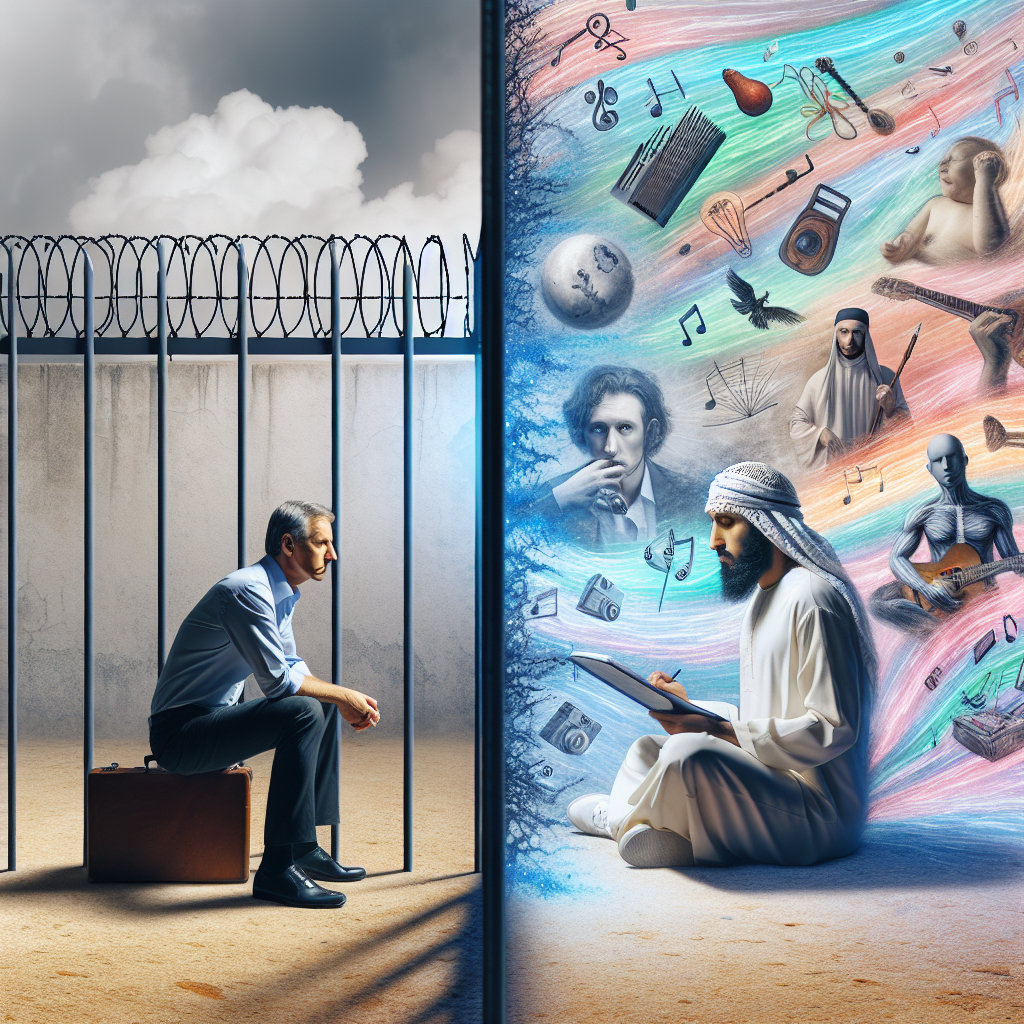-
Table of Contents

“Transforming Pain into Purpose: The Healing Power of Creative Expression in Overcoming Addiction”
Introduction
The Role of Creative Expression in Healing from Addiction
Addiction is a complex and multifaceted condition that affects millions of individuals worldwide, often leading to devastating physical, emotional, and social consequences. Traditional treatment methods, such as counseling, medication, and support groups, play a crucial role in the recovery process. However, an increasing body of research and clinical practice highlights the significant benefits of incorporating creative expression into addiction recovery programs. Creative expression, encompassing activities such as art, music, writing, dance, and drama, offers a unique and powerful avenue for individuals to explore and process their emotions, develop self-awareness, and foster a sense of purpose and connection. By engaging in creative activities, individuals in recovery can access and articulate feelings that may be difficult to express through conventional therapeutic approaches, thereby facilitating deeper healing and personal growth. This introduction explores the transformative potential of creative expression in the journey toward overcoming addiction, emphasizing its role in enhancing emotional resilience, promoting self-discovery, and building a supportive community.
Art Therapy: Harnessing Creativity for Addiction Recovery
Art therapy has emerged as a powerful tool in the realm of addiction recovery, offering individuals a unique avenue to explore and express their emotions. This form of therapy harnesses the transformative power of creativity, providing a non-verbal outlet for those grappling with the complexities of addiction. By engaging in artistic activities, individuals can access and process deep-seated emotions that may be difficult to articulate through traditional talk therapy. Consequently, art therapy serves as a bridge between the conscious and unconscious mind, facilitating a deeper understanding of oneself and one’s struggles.
One of the most compelling aspects of art therapy is its ability to bypass the defenses that often accompany verbal communication. For many individuals in recovery, discussing their experiences and emotions can be daunting. Art, however, allows them to express these feelings in a safe and non-judgmental environment. Through painting, drawing, sculpting, or other creative endeavors, individuals can externalize their internal experiences, making them more tangible and, therefore, more manageable. This process not only aids in emotional release but also fosters a sense of accomplishment and self-worth, which are crucial components of recovery.
Moreover, art therapy encourages mindfulness and presence, which are essential in combating the compulsive behaviors associated with addiction. Engaging in creative activities requires focus and concentration, drawing individuals into the present moment and away from the cravings and triggers that often lead to relapse. This mindful engagement can help individuals develop healthier coping mechanisms, replacing destructive habits with constructive and fulfilling activities. Over time, these new patterns of behavior can contribute to long-term sobriety and overall well-being.
In addition to its emotional and psychological benefits, art therapy also promotes social connection and community building. Group art therapy sessions provide a supportive environment where individuals can share their creations and experiences with others who understand their journey. This sense of community can be incredibly empowering, as it helps to combat the isolation and shame that often accompany addiction. By connecting with others through shared creative expression, individuals can build a network of support that is vital for sustained recovery.
Furthermore, the process of creating art can lead to profound personal insights and self-discovery. As individuals engage with their creative projects, they may uncover hidden aspects of themselves and their experiences. These revelations can be instrumental in understanding the root causes of their addiction and in developing strategies for healing. Art therapy, therefore, not only addresses the symptoms of addiction but also delves into the underlying issues, promoting holistic recovery.
It is also worth noting that art therapy is accessible to everyone, regardless of artistic skill or experience. The therapeutic value lies not in the final product but in the process of creation itself. This inclusivity makes art therapy a versatile and adaptable approach, suitable for individuals from all walks of life. Whether one is painting a canvas, molding clay, or simply doodling on paper, the act of creating can be a powerful catalyst for change.
In conclusion, art therapy offers a multifaceted approach to addiction recovery, addressing emotional, psychological, and social dimensions of healing. By providing a safe space for expression, fostering mindfulness, building community, and facilitating self-discovery, art therapy empowers individuals to reclaim their lives from the grip of addiction. As more people recognize the value of creative expression in the recovery process, art therapy will undoubtedly continue to play a pivotal role in helping individuals heal and thrive.
Music and Healing: The Therapeutic Power of Sound in Overcoming Addiction
Music has long been recognized as a powerful medium for emotional expression and connection, but its role in healing from addiction is particularly profound. The therapeutic power of sound can serve as a bridge to recovery, offering individuals a means to process their emotions, find solace, and rebuild their lives. As people navigate the tumultuous journey of overcoming addiction, music can provide a sense of stability and hope, acting as both a companion and a guide.
One of the most significant ways music aids in healing from addiction is through its ability to evoke and regulate emotions. Addiction often stems from an attempt to escape or numb overwhelming feelings, and the process of recovery requires confronting these emotions head-on. Music can facilitate this by providing a safe space for individuals to explore their feelings without judgment. Whether through listening to a poignant melody or creating their own compositions, individuals can express emotions that might be too difficult to articulate with words alone. This emotional release can be cathartic, helping to alleviate the burden of suppressed feelings and paving the way for emotional healing.
Moreover, music has the unique ability to connect people, fostering a sense of community and belonging that is crucial for those in recovery. Addiction can be an isolating experience, often leading to strained relationships and a sense of alienation. Participating in group music therapy sessions or joining a choir can help individuals rebuild social connections and develop a support network. The shared experience of making music can create bonds that transcend words, offering a sense of unity and mutual understanding. This communal aspect of music can be particularly empowering, reminding individuals that they are not alone in their struggles and that support is available.
In addition to its emotional and social benefits, music can also have a profound impact on the brain’s neurochemistry, which is often disrupted by addiction. Engaging with music can stimulate the release of dopamine, a neurotransmitter associated with pleasure and reward. This can help to counteract the dysregulation of the brain’s reward system that occurs with substance abuse, providing a natural and healthy source of pleasure. Furthermore, music can promote neuroplasticity, the brain’s ability to reorganize and form new neural connections. This can be particularly beneficial for individuals in recovery, as it supports the brain’s capacity to heal and adapt to new, healthier patterns of behavior.
The rhythmic and repetitive nature of music can also be grounding, helping individuals to manage stress and anxiety. Techniques such as drumming or rhythmic breathing exercises can induce a state of relaxation and mindfulness, reducing the physiological symptoms of stress. This can be especially valuable for those in recovery, as managing stress is a critical component of maintaining sobriety. By incorporating music into their daily routines, individuals can develop healthier coping mechanisms and enhance their overall well-being.
Ultimately, the therapeutic power of sound in overcoming addiction lies in its ability to touch the human spirit. Music can inspire hope, foster resilience, and provide a sense of purpose. It can remind individuals of their inherent worth and potential, encouraging them to persevere through the challenges of recovery. As they engage with music, individuals can rediscover their passions, rebuild their identities, and create a new narrative for their lives. In this way, music becomes not just a tool for healing, but a beacon of light guiding them towards a brighter, healthier future.
Q&A
1. How does creative expression aid in the healing process for individuals recovering from addiction?
– Creative expression, such as art, music, or writing, provides a non-verbal outlet for individuals to process and express complex emotions, reduce stress, and improve mental health, which can be crucial in the recovery process from addiction.
2. What are some specific forms of creative expression that have been found effective in addiction recovery?
– Specific forms of creative expression that have been found effective in addiction recovery include art therapy, music therapy, dance/movement therapy, and creative writing, all of which help individuals explore their feelings, build self-esteem, and develop coping strategies.
Conclusion
Creative expression plays a significant role in healing from addiction by providing individuals with a non-verbal outlet to process emotions, reduce stress, and build self-esteem. Engaging in activities such as art, music, writing, and dance allows individuals to explore their inner experiences and traumas in a safe and constructive manner. This form of expression can facilitate emotional release, enhance self-awareness, and foster a sense of accomplishment and purpose. Additionally, creative activities can serve as a healthy coping mechanism, replacing the harmful behaviors associated with addiction. Overall, incorporating creative expression into addiction recovery programs can significantly enhance the healing process and support long-term sobriety.



